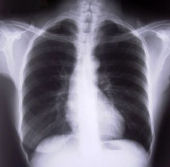
Purpose
To understand the mechanism of breathing through constructing a lung model and be able to answer the question, “What parts of the respiratory aids in breathing?”
Additional information
Humans need the oxygen in the air they breathe. Oxygen is needed to burn the food taken in. In order for the body to get a constant supply of oxygen and regularly remove carbon dioxide, you inhale and exhale air through the process of breathing. The parts that work together to help you breathe make up your respiratory system. When you breathe in, air is drawn into the lungs through the respiratory passage. The gaseous exchange occurs in the lungs. The lung is a sponge-like, cone shaped organ composed of three lobes and separated by pleural membranes. Through it, oxygen diffuses into the blood and for the cells to use. Carbon dioxide is then released by the body.
Sponsored Links
Required materials
- clear plastic
- cylindrical plastic bottle
- plastic Y-tube
- modeling clay
- small ice bag
- big rubber balloon
- two rubber bands
- adhesive tape
- scissors
- string
Estimated Experiment Time
Approximately 30 minutes
Step-By-Step Procedure
- 1. Cut the bottom of the plastic bottle with a scissors.
- 2. Cut the two ice bags to about 2.5 centimeters in length.
- 3. Tie one ice bag to each end of the Y-tube using rubber bands.
- 4. Carefully insert the Y-tube through the small opening made at the center of the plastic bottle.
- 5. Hold it in place by using modeling clay and to prevent air from entering or leaving.
- 6. Cut the balloon into two and use the part with the tip where you blow air into the balloon.
- 7. Stretch the balloon sheet under the open bottom of the bottle.
- 8. Use big rubber hands to hold it in place.
- 9. Tie a string at the middle of the stretched balloon sheet.
- 10. Pull the balloon and observe how the plastic bags attached to the Y-tube change in shape.
Note
Be careful in handling sharp objects like the scissors. Make sure that you tie the rubber bands tightly in places where you need them.
Observation
What do the parts of the model represent? What happens when you push and pull the balloon? How do these movements affect the plastic bags? In respiration, what do these movements represent?
Result
In this model, the stretched rubber balloon sheet represents the diaphragm; the plastic bags represent the lungs, and the Y-tube, the respiratory passageway. When you push and pull the balloon, the plastic ice bags also inflate and deflate. The muscular diaphragm moves when you breathe in and out. It is pulled flat when you breathe in. At the same time, the muscles between the ribs contract and pull the rib cage upward and outward. This action increases the volume of your chest. This allows the lungs to expand and suck in air. When you breathe out, the chest muscles and diaphragm relax. This causes the lung and the rib cage to expel air.
Sponsored Links
Take a moment to visit our table of Periodic Elements page where you can get an in-depth view of all the elements,
complete with the industry first side-by-side element comparisons!